Explore Suncheon - South Korea Travel, Asia
Suncheon, is a city known for its rich natural beauty, cultural heritage, and agricultural significance. Located in South Jeolla Province in southern South Korea, approximately 40 minutes north of the port city of Yeosu. The city is surrounded by mountains and is near the coast, providing a scenic backdrop and favorable conditions for agriculture and tourism. Its history stretches back to ancient times, having been part of the Mahan territory before going through several name changes during the Baekje, Unified Silla, and Goryeo periods. In 1413, it officially became Suncheon Dohobu during the Joseon Dynasty. A notable moment in its modern history is the Yeosu-Suncheon Rebellion in 1948, a significant uprising against the South Korean government.
Seeking a tailored South Korea adventure? Explore our premium Japan tour offerings here.
Population: approximately 280,000 as of 2024.
Economy: Suncheon has developed a strong tourism sector, attracting visitors to its natural attractions, such as Suncheon Bay and the Suncheon Bay National Garden. The city hosted the 2013 Suncheon Garden Expo, which showcased its commitment to green industry and sustainable tourism. The Suncheon Bay Wetland Reserve is also a major draw for eco-tourism.
Landmarks: Suncheon Bay National Garden, Suncheon Bay Wetland Reserve, Nagan Eupseong Folk Village, Suncheonman Bay Ecological Park, Deep-Rooted Tree Museum, Suncheon Open Film Location
South Korea
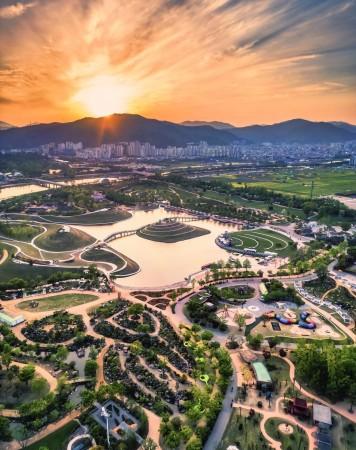
Overview of Suncheon
History & Culture Influence
Suncheon has a rich history that dates back to the Era of Samhan when it was part of the Mahan Confederacy. Throughout the Three Kingdoms period, it was known as a territory of Baekje, and later, during the Unified Silla, it became known as Seungpyeong-gun in 757. The city underwent various name changes and administrative reorganizations over the centuries, reflecting its evolving role in Korean history. In the modern era, Suncheon experienced significant turmoil during the Yeosu-Suncheon Rebellion in 1948, a pivotal event in Korean history that highlighted social and political tensions in the post-liberation period. This rebellion influenced local governance and community dynamics. Suncheon's cultural identity is shaped by its historical significance and natural beauty. The city is known for its commitment to environmental sustainability, particularly through the conservation of Suncheon Bay, recognized for its rich biodiversity and ecological value.
Interaction with The Locals
The city's population is relatively homogeneous, reflecting the overall demographic trends in South Korea. Suncheon is a popular tourist destination, particularly for its natural attractions such as Suncheon Bay and Suncheon Bay National Garden. As a result, locals are accustomed to interacting with visitors and are generally friendly and helpful. The city's focus on ecotourism and sustainable development has fostered a positive attitude towards tourists who appreciate and respect the local environment.
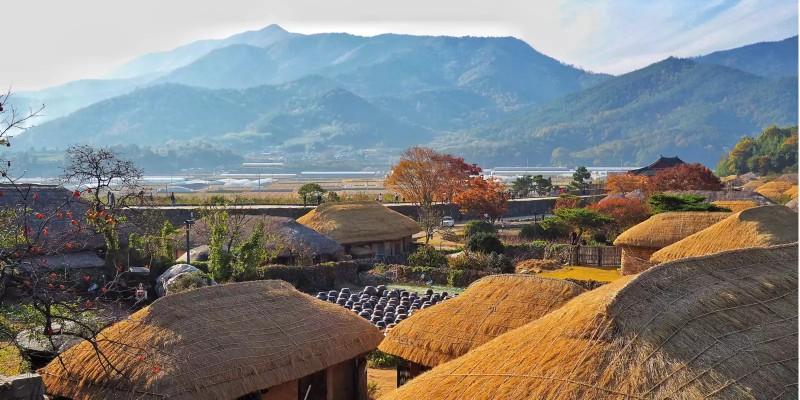
Nagan Eupseong Folk Village - © Daum Korea
Top attractions in Suncheon
Suncheon Bay National Garden
Suncheon Bay National Garden is a breathtaking 1.12 km² garden that was established to protect the delicate Suncheon Bay wetlands. This sprawling garden boasts an impressive collection of themed areas such as the Arboretum, World Garden Zone, and Wetland Zone. With over 860,000 trees and 650,000 vibrant flowers, it’s a must-see destination in every season, offering stunning displays of nature. The garden also serves as a gateway to the nearby wetlands, making it a perfect starting point for eco-friendly travelers.
Suncheon Bay Wetland Reserve
Home to an incredible variety of wildlife, Suncheon Bay Wetland Reserve is one of South Korea’s most significant coastal wetlands. Visitors can explore scenic walking trails and observation decks to take in the beauty of this thriving ecosystem, which houses over 1,400 species of plants and animals. A unique feature is the Sky Cube, a personal rapid transit system that conveniently connects the wetland reserve to the Suncheon Bay National Garden, offering an eco-friendly and scenic ride.
Nagan Eupseong Folk Village
Step back in time at Nagan Eupseong Folk Village, one of Korea's best-preserved traditional villages from the Joseon Dynasty. The village is surrounded by an ancient fortress wall and dotted with thatched-roof houses, showcasing authentic Korean architecture. Visitors can immerse themselves in the historical ambiance, experiencing traditional crafts, local foods, and scenic views of the surrounding landscape.
Jogyesan Mountain
Jogyesan Mountain offers nature lovers an escape into beautiful landscapes, serene hiking trails, and cultural history. One of the highlights of the area is Seonamsa Temple, a stunning Buddhist temple with a history dating back to the 9th century. The mountain’s peaceful environment, combined with its scenic beauty, makes it a perfect destination for those looking to hike, reflect, or explore Korea's spiritual heritage.
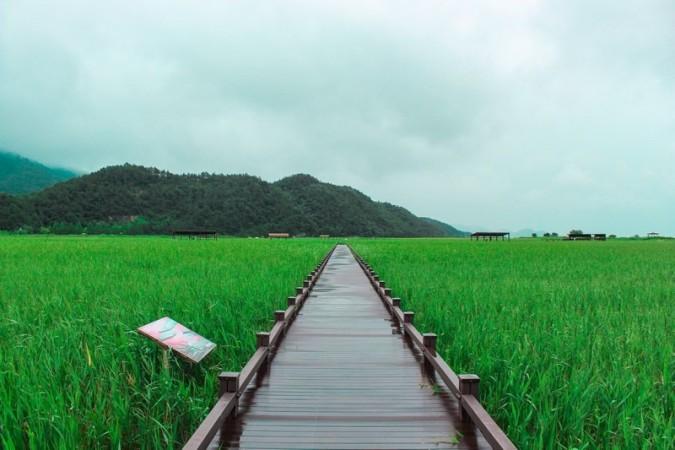
Suncheon Bay Wetland Reserve - © The Soul of Seoul
Must-Try Dishes in Suncheon
Suncheon offers a variety of must-try dishes that showcase the region's fresh ingredients and culinary heritage and highlight the unique Suncheon's coastal flavors.
- Suncheon Bibimbap: Suncheon Bibimbap is a must-try dish that perfectly represents the region’s fresh produce and culinary style. This colorful meal combines seasoned vegetables, beef, and a raw or fried egg, all beautifully arranged over warm white rice. Often accompanied by Suncheon’s famous namul (seasoned vegetables), the dish is both a feast for the eyes and a harmonious blend of flavors.
- Suncheon Makguksu: A refreshing favorite during the hot summer months, Suncheon Makguksu is a cold buckwheat noodle dish served with toppings like cucumber, boiled egg, and spicy gochujang sauce. The light, chilled broth makes this dish a perfect choice for cooling down, and it can be found in many of Suncheon’s local restaurants.
- Suncheon Pork Rice Soup: This comforting soup, known for its clean, non-greasy flavor, is made with tender pork, bean sprouts, and rice simmered in a savory broth. Often served with boiled pork as a side dish, Suncheon Pork Rice Soup is a local favorite for breakfast or lunch, and it’s renowned for its ability to cure hangovers.
- Suncheon Cockle Dishes: Known for its high-quality seafood, Suncheon boasts some of the best cockle dishes in Korea. Visitors can enjoy a variety of preparations, including sweet and sour cockle salad, steamed cockles, and blanched cockles served with rice, highlighting the city’s coastal bounty and fresh flavors.
- Suncheon Mudskipper Fish Soup: Mudskipper fish, found in Suncheon Bay’s mudflats, is the star of this spicy soup, believed to boost health and relieve travel fatigue. Boiled with vegetables and spices, Suncheon Mudskipper Fish Soup offers a unique, nutritious experience for adventurous food lovers.
Curious about the scenic beauty of Buyeo? Find out what makes it so special here in our in-depth travel guide.
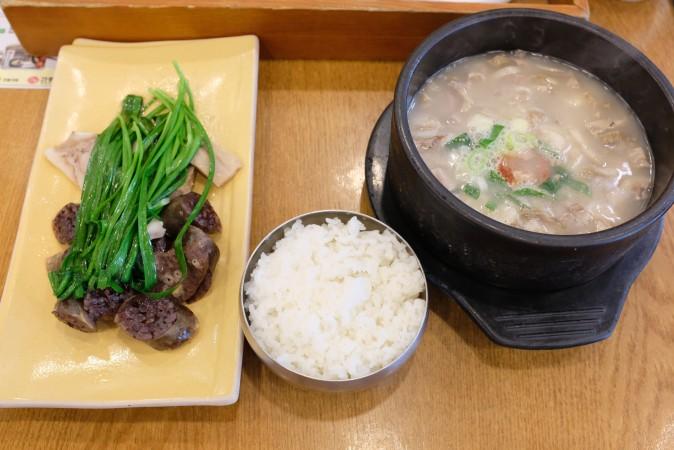
Suncheon Pork Rice Soup - © Hi There Im Jun
Festivals & Local Celebrations
- Suncheon Bay Reed Festival: Celebrate the breathtaking beauty of Suncheon Bay’s golden reeds during this vibrant festival. Visitors can enjoy a range of cultural performances, art exhibitions, and interactive activities, all set against the stunning backdrop of one of Korea’s most significant wetlands.
- Suncheon Cultural Heritage Night: Immerse yourself in Korean traditions at Suncheon Cultural Heritage Night, where you can experience live performances, traditional crafts, and authentic cuisine. This evening event brings to life the rich cultural legacy of Suncheon and its surrounding regions.
- Suncheon Food & Art Festival: This lively festival blends the best of Suncheon’s culinary scene with local artistic talent. Visitors can indulge in delicious regional dishes while enjoying art exhibitions and live performances that showcase the creative spirit of the city.
- Naganeupseong Folk Village Culture Festival: Step back in time at the Naganeupseong Folk Village Culture Festival, where traditional games, performances, and hands-on workshops celebrate the cultural history of Suncheon. The historic village provides a perfect setting for this unique cultural experience.
- Starlight Festival: For astronomy lovers, the Starlight Festival offers an unforgettable night of stargazing, educational talks, and interactive activities. Set beneath the clear skies of Suncheon, this festival showcases the beauty of the stars while offering a peaceful escape into nature.
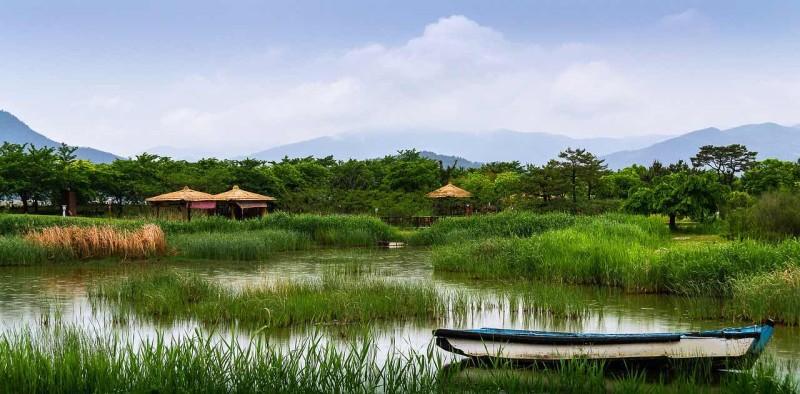
Suncheon Bay Reed - © ITASEOUL
What to Do in Suncheon
- Explore Suncheon Bay Wetland Reserve: Visitors can enjoy the stunning natural beauty of the Suncheon Bay Wetland Reserve, which is home to diverse flora and fauna. The reserve offers walking trails and observation points for birdwatching, especially during migratory seasons. This eco-friendly destination is perfect for nature lovers and photographers.
- Visit Nagan Eupseong Folk Village: Nagan Eupseong Folk Village is a well-preserved traditional village that provides a glimpse into Korea's past. Visitors can explore thatched-roof houses, fortress walls, and experience traditional Korean culture. The village often hosts cultural events and workshops, allowing tourists to engage with local customs.
- Hike Jogyesan Mountain: For outdoor enthusiasts, hiking Jogyesan Mountain offers beautiful views and a chance to connect with nature. The trails vary in difficulty, making it accessible for different skill levels. The mountain is also home to the serene Songgwangsa Temple, adding a cultural element to the hike.
- Tour the Suncheon Open Film Set: The Suncheon Open Film Set is an outdoor film set that recreates urban and rural scenes from the 1950s to 1970s. Visitors can explore the various sets used in popular Korean dramas and films, making it a unique experience for fans of Korean cinema. Guided tours are available, providing insights into the filmmaking process.
- Enjoy Local Cuisine: Suncheon is known for its delicious local dishes, including Suncheon Bibimbap and fresh seafood. Visitors can explore local markets and restaurants to sample traditional Korean cuisine. The vibrant food scene offers a chance to experience the flavors of the region.
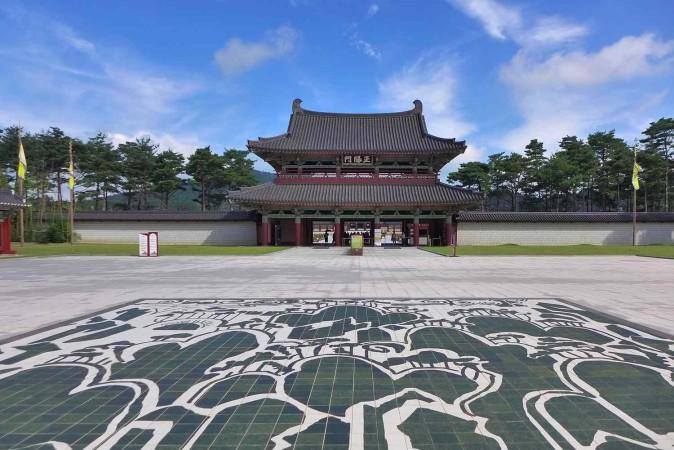
Baekje Cultural, Suncheon - © ThoughtCo
Weather in Suncheon: Best Time to Visit
Average Temperatures
- Summer (June to August): Average highs range from 25°C (77°F) in June to 30°C (86°F) in August. Average lows are around 21-22°C (70-72°F) during these months.
- Autumn (September to November): Average highs decrease from 27°C (81°F) in September to 14°C (57°F) in November. Average lows range from 17°C (63°F) in September to 4°C (39°F) in November.
- Winter (December to February): Average highs range from 6°C (43°F) in January to 11°C (52°F) in February. Average lows can drop to -1°C (30°F) in January.
- Spring (March to May): Average highs increase from 12°C (54°F) in March to 22°C (72°F) in May. Average lows range from 2°C (36°F) in March to 13°C (55°F) in May.
Best Time to Travel
The best times to visit Suncheon are during spring (April to May) and autumn (September to October). During these months, visitors can enjoy mild temperatures, beautiful natural scenery, and fewer crowds. Spring is particularly famous for cherry blossoms, while autumn showcases stunning fall foliage.
Looking to add more adventure to your journey? Danyang awaits with unique experiences—explore more here.
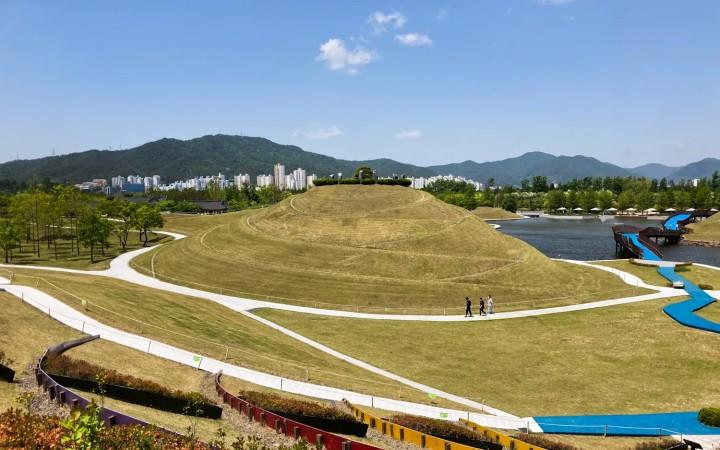
Suncheon Bay National Garden - © Roamad
Essential Travel Information
Getting Around Suncheon
- Train Services: Suncheon is accessible via the KTX and regular trains. From Gwangju Songjeong Station, there are trains that run to Suncheon Station, taking about 1 hour .
- Public Transit: Frequent intercity buses operate from major cities like Gwangju and Yeosu to Suncheon. The bus ride from Gwangju takes approximately 1 hour and 30 minutes. Tickets can be reserved online .
- Buses: Suncheon has a reliable public bus system that connects major attractions and neighborhoods. Buses are a convenient way to navigate the city.
- Taxis: Taxis are widely available throughout Suncheon. They are a convenient option for getting around, especially for visitors with luggage or those traveling in groups. Fares start at approximately ₩3,800, with metered rates applying thereafter.
ATM & Banking Services
In Suncheon, accessing banking services is convenient for both locals and travelers. Numerous ATMs are scattered throughout the city, providing easy withdrawal of cash in various currencies. Major banks have branches in key areas, offering services such as currency exchange, account management, and financial consultations. Many establishments, including restaurants and shops, accept credit and debit cards, making transactions hassle-free.
Where to Stay in Suncheon
- Luxury Resorts: If you're looking to indulge, Suncheon offers upscale resorts that provide premium services and stunning views of the surrounding landscapes. These luxury accommodations often feature spa facilities, fine dining restaurants, and spacious rooms with modern amenities.
- Eco-Friendly Lodgings: Given Suncheon's commitment to sustainability and nature conservation, eco-friendly accommodations are becoming increasingly popular. These lodgings prioritize environmentally friendly practices, offering guests a chance to enjoy a guilt-free stay amidst nature.
- Traditional Hanok Stays: These charming accommodations allow you to immerse yourself in the local culture and enjoy unique architectural features. Many hanok stays are located near attractions such as the Suncheon Bay National Garden and the Nagan Eupseong Folk Village, providing a tranquil retreat after a day of exploring.
Articles for you

Experience Aboard The RV Indochine II - A Mekong Cruise With Tweet World Travel
The RV Indochine II is a luxury river cruise ship, offering an unforgettable journey through many attractions along the Mekong River. Built in 2017, this upscale vessel combines colonial elegance with modern conveniences to create a comfortable yet stylish environment for its crew and passengers. The ship’s intimate size makes it ideal for those seeking a more personal cruising experience while exploring Vietnam and Cambodia rich culture, scenery, and heritage. Whether you're gazing at the landscape from your private balcony or enjoying authentic local cuisine, RV Indochine II promises an exotic adventure like no other.

Witness Stilt Fishing In Sri Lanka: An Eco-Tourism Experience
Sri Lanka, renowned for its stunning beaches and rich cultural heritage, harbors a unique tradition that has captivated travelers for centuries: stilt fishing. This ancient practice, passed down through generations of coastal communities, blends artistry with necessity, offering a glimpse into a way of life intimately connected to the island's coastal rhythms. Stilt fishing in Sri Lanka isn't merely a means to catch fish; it's a cultural emblem, embodying the resilience and ingenuity of Sri Lanka's fishing communities.

Make Your Trip Stress-Free With The Tweet Trip App
Embark on your next adventure with confidence by downloading the Tweet Trip App, available for both iOS and Android. This essential travel companion allows you to view your detailed itinerary, stay connected with your tour guide and fellow travelers, receive real-time updates, and provide feedback effortlessly. With features like in-app messaging, emergency assistance, and location sharing, the Tweet Trip App ensures you travel smarter, stay connected, and enjoy a seamless, worry-free journey. Get started today and make the most of your travel experience with Tweet World Travel.

Pedal Through Paradise: Unveiling Cambodia's Hidden Gems on Two Wheels
The gentle whir of bicycle wheels mingles with the distant chants of monks as you glide past emerald rice paddies stretching to the horizon. This is Cambodia - a sensory explosion waiting to be experienced on two wheels. At Tweet Tours, we believe there's no better way to immerse yourself in the Kingdom of Wonder than by bicycle.
Cambodia isn't just a destination; it's a living, breathing tapestry of ancient wonders, natural beauty, and vibrant culture. Our carefully crafted cycling tours take you beyond the typical tourist haunts, offering a unique perspective on this captivating country. Ready to clip in and discover the magic of Cambodia? Let's ride!

Trekking in the Himalayas: A Journey Through Nepal's Majestic Peaks
The Himalayas rise from the earth like colossal guardians, their snow-capped peaks piercing the sky in a display of nature's raw power and beauty. Nepal, nestled at the heart of this mountain range, serves as the gateway to some of the most breathtaking trekking experiences on the planet. Here, the air is crisp and thin, filled with the promise of adventure and the whispers of ancient tales.
With Tweet Tours, as you set foot on these hallowed trails, you're not just a traveler - you're a modern-day explorer, following in the footsteps of legendary mountaineers and age-old traders. Each step takes you further into a world where nature reigns supreme and human resilience is tested against the backdrop of some of the world's highest peaks.
From the moment your boots touch the ground in Kathmandu, you'll feel the pull of the mountains. The bustling streets of the capital, with their sensory overload of sights, sounds, and smells, soon give way to serene mountain paths where the only soundtrack is the crunch of gravel underfoot and the distant tinkling of yak bells.

Exploring Mui Ne's Wonders: Unique Attractions & Local Dishes
Nestled along the southeastern coast of Vietnam, Mui Ne emerges as a captivating gem, blending natural wonders with cultural richness. Renowned for its stunning landscapes and unique attractions, Mui Ne beckons travelers seeking both relaxation and adventure in equal measure. Mui Ne's renowned beach dunes, bustling fishing towns, and excellent local food await exploration at every turn.
The allure of Mui Ne lies not only in its pristine beaches and crystal-clear waters but also in its diverse range of activities catering to every traveler's whims. Whether you're drawn to thrilling water sports like kitesurfing and windsurfing on its dynamic shores or seeking tranquility amidst the picturesque Fairy Stream, Mui Ne promises an unforgettable journey filled with discovery.
